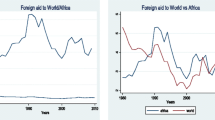Abstract
If development assistance targeted at specific sectors is not used as intended, aid is said to be fungible. Using country-specific estimates of the degree of aid fungibility in “pro-poor” government expenditure sectors, I assess the effect on child mortality. Results indicate that fungibility within these sectors does not help to explain differences in mortality. However, when separating the sample into democracies and non-democracies, results suggest that pro-poor expenditures influence mortality in non-democracies only and that aid treated as fungible tends to be used efficiently in democracies.
Similar content being viewed by others
References
Boone, P. (1996). Politics and the Effectiveness of Foreign Aid. European Economic Review 40 (2): 289–329.
Chauvet, L., and P. Collier (2007). What Are the Preconditions for Turnarounds in Failing States? Mimeo. Centre for the Study of African Economies, Oxford University.
Chen, S., and M. Ravaillon (2004). How Have the World’s Poorest Fared Since the Early 1980’s? World Bank Research Observer 19 (2): 141–169. Data available at <http://iresearch.worldbank.org/PovcalNet/jsp/index.jsp>.
Clemens, M. A., S. Radelet, and R. Bhavnani (2004). Counting Chickens When They Hatch: The Short-Term Effect of Aid on Growth. Center for Global Development Working Paper 44. Washington, D.C.
Devarajan, S., and V. Swaroop (1998). The Implications of Foreign Aid Fungibility for Development Assistance. Mimeo. Development Research Group, World Bank, Washington, D.C.
Devarajan, S., A. S. Rajkumar, and V. Swaroop (1999). What Does Aid to Africa Finance? Policy Research Working Papers 2092. World Bank, Washington, D.C.
Dreher, A., P. Nunnenkamp, and R. Thiele (2006). Does Aid for Education Educate Children? Evidence from Panel Data. Kiel Working Papers 1290. Kiel Institute for the World Economy, Kiel.
Ekman, B., and K. Metell (1993). Foreign Aid and Fungibility: The Kenyan Case. Undergraduate Thesis in Economics, Department of Economics, Stockholm University.
Feyzioglu, T., V. Swaroop, and M. Zhu (1998). A Panel Data Analysis of the Fungibility of Foreign Aid. World Bank Economic Review 12 (1): 29–58.
Filmer, D., and L. Pritchett (1999). The Impact of Public Spending on Health: Does Money Matter? Social Science & Medicine 49: 1309–1323.
Gomanee, K., S. Girma, and O. Morrissey (2005a). Aid, Public Spending and Human Welfare: Evidence from Quantile Regressions. Journal of International Development 17 (3): 299–309.
Gomanee, K., O. Morrissey, P. Mosley, and A. Verschoor (2003). Aid, Pro-Poor Government Spending, and Welfare. CREDIT Research Paper 03/03. Centre for Research in Economic Development and International Trade, University of Nottingham.
Gomanee, K., O. Morrissey, P. Mosley, and A. Verschoor (2005b). Aid, Government Expenditure, and Aggregate Welfare. World Development 33 (3): 355–370.
Holmqvist, G. (2000). Fungibility Parameters: A Comment on Their Reliability and Policy Implications from an Aid Practitioner. Paper presented at the SIDA conference on Aid and Development. January 20–21, Stockholm.
IMF (International Monetary Fund) (2003). Government Finance Statistics Database. CD-ROM, Washington, D.C.
Knack, S., and P. Keefer (1995). Institutions and Economic Performance: Cross-Country Tests Using Alternative Institutional Measures. Economic and Politics 7 (3): 207–227.
Kosack, S. (2003). Effective Aid: How Democracy Allows Development Aid to Improve the Quality of Life. World Development 31 (1): 1–22.
Marshall, M. G., and K. Jaggers (2002). Polity IV Project. Political Regime Characteristics and Transitions, 1800–2002. Integrated Network for Social Conflict Research (INSCR) Program. Center for International Development and Conflict Management. University of Maryland. Available at <www.cidcm.umd.edu/inscr/polity>.
McGillivray, M., and O. Morrissey (2000). Aid Fungibility in Assessing Aid: Red Herring or True Concern? Journal of International Development 12 (3): 413–428.
McGillivray, M., and O. Morrissey (2001a). Aid Illusion and Public Sector Fiscal Behaviour. Journal of Development Studies 37 (6): 118–136.
McGillivray, M., and O. Morrissey (2001b). A Review of Evidence on the Fiscal Effects of Aid. CREDIT Research Paper 01/13. Centre for Research in Economic Development and International Trade, University of Nottingham.
Mosley, P., J. Hudson, and A. Verschoor (2004). Aid, Poverty Reduction and the “New Conditionality”. Economic Journal 114 (June): 217–243.
Osmani, S. R. (1992). On Some Controversies in the Measurement of Undernutrition. In S. R. Osmani (ed.), Nutrition and Poverty. Oxford: Clarendon Press.
Pack, H., and J. R. Pack (1990). Is Foreign Aid Fungible? The Case of Indonesia. Economic Journal 100 (March): 188–194.
Pack, H., and J. R. Pack (1993). Foreign Aid and the Question of Fungibility. Review of Economics and Statistics 75 (2): 258–265.
Pack, H., and J. R. Pack (1998). Foreign Aid and Fiscal Stress. In G. Saxonhouse and T. N. Srinivasan (eds.), Development, Duality, and the International Regime: Essays in Honor of Gustav Ranis. Michigan: University of Michigan Press.
Pettersson, J. (2007). Foreign Sectoral Aid Fungibility, Growth and Poverty Reduction. Journal of International Development 19 (8): 1074–1098.
Reinikka, R., and J. Svensson (2004). Local Capture: Evidence from a Central Government Transfer Program in Uganda. Quarterly Journal of Economics 119 (2): 679–705.
Strand, H., L. Wilhelmsen, and N. P. Gleditsch (2002). Armed Conflict Dataset Codebook. Version 1.1. Oslo: International Peace Research Institute.
Svensson, J. (2000). When Is Foreign Aid Policy Credible? Aid Dependence and Conditionality. Journal of Development Economics 61 (1): 61–84.
Svensson, J. (2003). Why Conditional Aid Does Not Work and What Can Be Done About It? Journal of Development Economics 70 (2): 381–402.
Swaroop, V., S. Jha, and A. S. Rajkumar (2000). Fiscal Effects of Foreign Aid in a Federal System of Governance. The Case of India. Journal of Public Economics 77 (3): 307–330.
Tavares, J. (2003). Does Foreign Aid Corrupt? Economics Letters 79 (1): 99–106.
UNDP (United Nations Development Programme) (2005). Human Development Report. Available at: <http://hdr.undp.org/statistics/data/>.
White, H. (1998). Aid and Macroeconomic Performance. In H. White (ed.), Aid and Macroeconomic Performance. London: Palgrave Macmillan.
World Bank (1998). Assessing Aid. What Works, What Doesn’t, and Why. A World Bank Policy Research Report. Oxford: Oxford University Press.
World Bank (various issues). World Development Indicators. CD-ROM, Washington, D.C.
Author information
Authors and Affiliations
Corresponding author
Additional information
JEL no.
F35, O11, O23
About this article
Cite this article
Pettersson, J. Child Mortality: Is Aid Fungibility in Pro-Poor Expenditure Sectors Decisive?. Rev World Econ 143, 673–693 (2007). https://doi.org/10.1007/s10290-007-0127-7
Issue Date:
DOI: https://doi.org/10.1007/s10290-007-0127-7




